All waves diffract, if they pass through or around obstacles, and
interfere, if two or more waves arrive at the same place at the same time.
When a monochromatic plane wave passes through a single slit of width
w, we observe a
Fraunhofer single slit diffraction pattern a large distance L >>
w away from the slit. When the wave passes through multiple
regularly-spaced slits with slit-spacing d, we observe a
multiple-slit Fraunhofer interference pattern a large distance L >> d away from the slits.
Light is an electromagnetic wave. You will use a simulation to observe
a He-Ne laser beam (λ = 633 nm) to produce diffraction and interference pattern.
You will use these patterns to measure the width of a single slit and a hair and
the spacing of two slits.
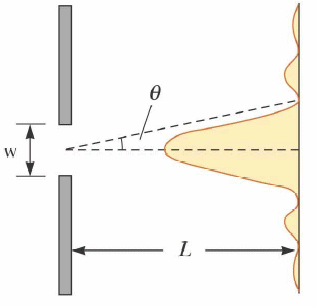 When monochromatic light from a distant source passes
through a narrow slit of width w in an opaque mask we observe a
diffraction pattern on a distant
screen. The pattern is characterize by a central maximum and
alternating dark and bright fringes, which appear symmetrically in both
sides of the central maximum. The central maximum is twice as
wide, and much brighter than the other bright fringes.
When monochromatic light from a distant source passes
through a narrow slit of width w in an opaque mask we observe a
diffraction pattern on a distant
screen. The pattern is characterize by a central maximum and
alternating dark and bright fringes, which appear symmetrically in both
sides of the central maximum. The central maximum is twice as
wide, and much brighter than the other bright fringes.

The dark fringes in the diffraction pattern of a single slit are found at
angles θ for which w sinθ = mλ, where λ
is the wavelength of the light and m is an integer, m = 1, 2, 3, ... .
If light with wavelength λ passes through two or more
slits separated by equal distances d, we will observe interference
fringes inside the single slit diffraction pattern. At certain angles
we observe constructive interference. These angles are found by
applying the condition for constructive
interference, which is
d sinθ = mλ, m = 0, 1, 2, ....
We will only see the bright interference fringes, if
they do not appear at the angle θ of a diffraction minimum. If d
sinθ = mλ = w
sinθ, then the bright fringe of order m will be missing. Look again
at this picture!
In this session you will use
a helium-neon (HeNe) laser to determine the
number of grooves per mm of a diffraction grating, to measure the
distance d between adjacent wires and the width w of the gap between the
wires of 2-dimensional wire mesh, and to measure the width of a human
hair.
Equipment needed:
- optical bench with optical holders
- helium neon (HeNe) laser (λ = 632.8 nm)
- transmission grating
- wire mesh
- slit and transverse ruler
- ruler, index card, tape
Open a Microsoft Word document to keep a log of your procedures. This log will become your lab report. Address the points
highlighted in blue. Answer all questions.
Experiment 1
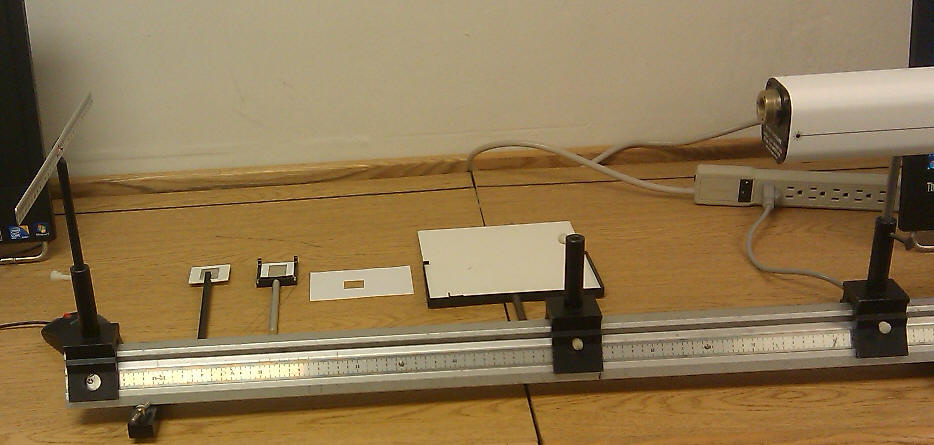
 Use the equipment provided to
determine the number of grooves per mm of a
diffraction grating.
Use the equipment provided to
determine the number of grooves per mm of a
diffraction grating.
- Mount the HeNe laser and the transverse ruler onto the optical
bench.
- Mount the ruler 30 cm above the table. That will allow you
to move the other components into place. Make sure the ruler
is perpendicular to the track.
- Align the laser so that it shines through the hole in the center
of the ruler and then tighten everything down securely. Spend
some time on this procedure, so the alignment is as good as
possible.
- Move the grating into place. Make sure the grooves are
vertical. Observe the first order
interference maxima on the ruler. Rotate the grating until
they are symmetric about the middle, and move the grating along the
track, so the distance from the center of the ruler to the maxima
can be measured with a small uncertainty.
- Measure the distance from the grating to the ruler and then
calculate the sine of the deflection angle θ.
- Determine the spacing d between the grooves of the grating from
d sinθ = λ in units of mm and then determine the number of
grooves/mm = 1/d.
- Make at least 2 independent measurements for two different
grating-ruler distances.
Record all your measurements and calculations
and results in your log
Discuss and comment on your results. Did anything surprise you?
Experiment 2
Use the equipment provided to measure the
width of a human hair.
The dark fringes in the diffraction pattern of a single slit are found at
angles θ for which w sinθ = mλ, where λ
is the wavelength of the light and m is an integer, m = 1, 2, 3, ... .
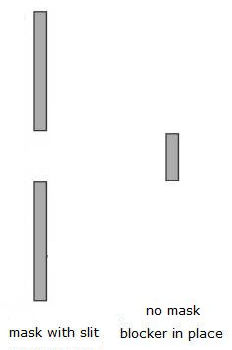 The intensity at the screen is proportional to the
square of the electric field amplitude.
The intensity at the screen is proportional to the
square of the electric field amplitude.
- If we block the slit completely with an opaque
blocker, the electric field at a large distance is zero.
- If we remove mask with the slit, the electric field
at a large distance is that of the non-diffracted beam.
What if we remove the mask and only leave the blocker of
width w? Using Huygens' principle we have
Emask with slit +
Eblocker (no mask) = Enon-diffracted beam.
Here Emask with slit is the field
produced by sources at locations of the mask and Eblocker
(no mask) is the field produced by source at locations of the
blocker.
Therefore
Eblocker (no mask) =
Enon-diffracted
beam - Emask with slit.
For a laser beam the divergence angle θ0 is
small, and for angles θ > θ0 we have
Eblocker (no mask) = -
Emask with slit.
For angles θ > θ0 the average intensity,
which is proportional to the square of the electric field, therefore is
the same as that for the single slit. Dark fringes in the
diffraction pattern are found at angles θ for
which w sinθ = mλ.
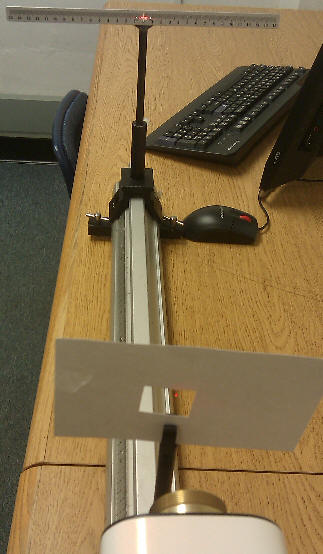 Cut a hole into an index card and tape a hair across the hole.
Make sure the hair is stretched out and you can mount it vertically.
Cut a hole into an index card and tape a hair across the hole.
Make sure the hair is stretched out and you can mount it vertically.- Mount the index card into a holder close to the laser.
- Adjust its position until the laser shines onto the hair.
- Observe the diffraction pattern on the ruler.
- Measure the distance to the mth minimum, the one farthest away
from the center that you can clearly identify. Measure on both
side of the center and average.
- Measure the distance from the hair to the ruler and then
calculate the sine of the deflection angle θ.
- Determine the width of the hair w from w
sinθ = mλ,
where m is the order of the minimum you have chosen.
Record all your measurements and calculations
and results in your log
Discuss and comment on your results. Did anything surprise you?
Experiment 3
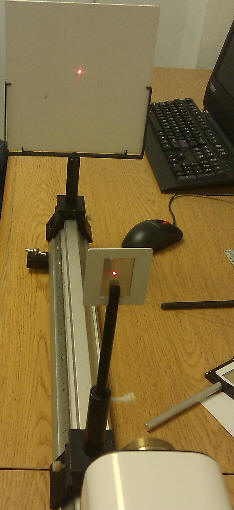 Use the equipment provided to measure the distance d between adjacent wires and
the width w of the gap between the wires of 2-dimensional wire mesh.
Use the equipment provided to measure the distance d between adjacent wires and
the width w of the gap between the wires of 2-dimensional wire mesh.
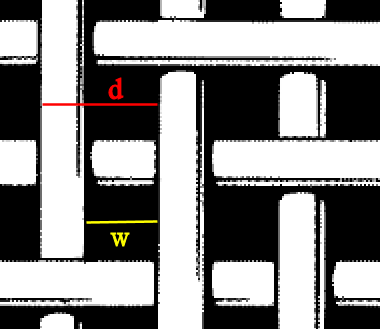
- Replace the ruler with the screen. Replace the index card
with the wire mesh.
- Observe the 2-dimensional diffraction/interference pattern on
the screen.
- Measure the distance between the center of the pattern and the
mth interference maximum and the mesh-screen distance to find sinθ.
- Calculate the distance d between adjacent wires from d sinθ = mλ.
- Measure the distance from the center of the pattern and
the first diffraction minimum (where an interference maximum is
missing) and find sinθ'.
- Calculate the width w of the gap
between the wires from w sinθ' = λ.
Record all your measurements and calculations
and results in your log
Discuss and comment on your results. Did anything surprise you?
Convert your log into a lab report.
See the grading scheme for all lab
reports.
Name:
E-mail address:
Laboratory 9 Report
- In one or two sentences, state the goal of this lab.
- Make sure you completed the entire lab and answered all parts. Make
sure you show your work and inserted and properly labeled relevant tables
and plots.
- Add a reflection at the end of your report in a short essay format.
Save your Word document (your name_lab9.docx), go to Canvas, Assignments, Lab
9, and submit your document.
 When monochromatic light from a distant source passes
through a narrow slit of width w in an opaque mask we observe a
diffraction pattern on a distant
screen. The pattern is characterize by a central maximum and
alternating dark and bright fringes, which appear symmetrically in both
sides of the central maximum. The central maximum is twice as
wide, and much brighter than the other bright fringes.
When monochromatic light from a distant source passes
through a narrow slit of width w in an opaque mask we observe a
diffraction pattern on a distant
screen. The pattern is characterize by a central maximum and
alternating dark and bright fringes, which appear symmetrically in both
sides of the central maximum. The central maximum is twice as
wide, and much brighter than the other bright fringes.

 Use the equipment provided to
determine the number of grooves per mm of a
diffraction grating.
Use the equipment provided to
determine the number of grooves per mm of a
diffraction grating. The intensity at the screen is proportional to the
square of the electric field amplitude.
The intensity at the screen is proportional to the
square of the electric field amplitude.  Cut a hole into an index card and tape a hair across the hole.
Make sure the hair is stretched out and you can mount it vertically.
Cut a hole into an index card and tape a hair across the hole.
Make sure the hair is stretched out and you can mount it vertically. Use the equipment provided to measure the distance d between adjacent wires and
the width w of the gap between the wires of 2-dimensional wire mesh.
Use the equipment provided to measure the distance d between adjacent wires and
the width w of the gap between the wires of 2-dimensional wire mesh.